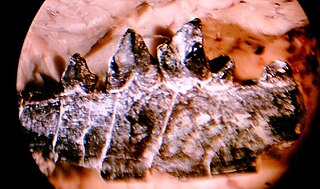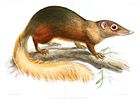Hainina is an extinct mammal genus from the latest Cretaceous to the Paleocene of Europe.

Sudamerica, literally "South America" in Spanish, is a genus of mammal from the extinct suborder Gondwanatheria that lived in Patagonia, Argentina and Antarctica from the Middle Paleocene (Peligran), just after the end of the "Age of Dinosaurs", to the Early Eocene (Casamayoran).

Paucituberculata is an order of South American marsupials. Although currently represented only by the seven living species of shrew opossums, this order was formerly much more diverse, with more than 60 extinct species named from the fossil record, particularly from the late Oligocene to early Miocene epochs. The earliest paucituberculatans date to the late Paleocene. The group went through a pronounced decline in the middle Miocene epoch, which resulted in the extinction of all families of this order except for the living Caenolestidae.
Cimolestes is a genus of early eutherians with a full complement of teeth adapted for eating insects and other small animals. Paleontologists have disagreed on its relationship to other mammals, in part because quite different animals were assigned to the genus, making Cimolestes a grade taxon of animals with similar features rather than a genus of closely related ones. Fossils have been found in North America, South America, Europe and Africa. Cimolestes first appeared during the Late Cretaceous of North America. According to some paleontologists, Cimolestes died out at the start of the Paleocene, while others report the genus from the early Eocene.
Oldfieldthomasiidae is an extinct family of notoungulate mammals known from the Late Paleocene to Late Eocene of South America. The family was classified by George Gaylord Simpson in 1945 and a synonym is Acoelodidae, defined by Florentino Ameghino in 1901.

Ictidopappus is an extinct genus of mammals from extinct subfamily Ictidopappinae within extinct family Viverravidae, that lived in North America during the early Paleocene.
Peligrotherium is an extinct dryolestoid, and the sole member of the family Peligrotheriidae, from the Paleocene of Patagonia, originally interpreted as a stem-ungulate. Its remains have been found in the Salamanca Formation. It was a dog-sized mammal, among the largest of all dryolestoids, and closely related to mesungulatids, another lineage of large sized herbivorous dryolestoids. A recent phylogenetic study finds it to be the sister taxon to Reigitherium.
The Tiupampan age is a period of geologic time within the Paleocene epoch of the Paleogene used more specifically with South American land mammal ages (SALMA). It is the oldest SALMA age and precedes the Peligran age.
The Peligran age is a period of geologic time within the Paleocene epoch of the Paleogene, used more specifically with South American land mammal ages (SALMA). It follows the Tiupampan and precedes the Riochican age.

The Itaboraian age is a period within the Early Eocene geologic time epoch of the Paleogene, used more specifically with South American land mammal ages (SALMA). It follows the Riochican and precedes the Casamayoran age.
The Riochican age is a period of geologic time within the Paleocene and Eocene epochs of the Paleogene, used more specifically within the South American land mammal ages (SALMA). It follows the Peligran and precedes the Itaboraian age.
Anagaloidea, an extinct order of placental mammals that first appeared during the Paleocene epoch.
Umayodus is an extinct genus of "condylarth" mammal from the late Paleocene or the earliest Eocene. It is a didolodontid which lived in what is now Peru. It is known from the holotype LU3-801, an isolated right third molar, which was found in the Muñani Formation of Laguna Umayo, Peru. It was first named by Javier N. Gelfo and Bernard Sigé in 2011 and the type species is Umayodus raimondi.
Afrodon is an extinct genus of eutherians in the family Adapisoriculidae. Its type species is Afrodon chleuhi, known from the late Palaeocene of Morocco. The other known species are Afrodon germanicus from the late Palaeocene of Germany and France, Afrodon tagourtensis from the early Eocene of Morocco, Afrodon ivani from the late Palaeocene of Spain, and Afrodon gheerbranti from the early Paleocene of Belgium. Its range spread from the Cernaysian to the Grauvian in the European land mammal ages.
Meiostylodon is an extinct genus of tillodont that lived during Paleocene. The lone type species, M. zaoshiensis, is known only from three isolated teeth found at Zaoshi, Chaling County, Hunan Province in the People's Republic of China. These isolated fossil teeth are stored at the Paleozoological Museum of China.
Micromomyidae (Micromomids) is a family of extinct plesiadapiform mammals that include some of the earliest known primates. The family includes five genera that lived from the Paleocene epoch into the early Eocene epoch.
Plesiadapoidea was an extinct superfamily of primates that existed during the Paleocene and Eocene in Canada, Europe, and Asia.
Wyonycteris is a genus of small mammals that existed in the late Paleocene and early Eocene epochs. The type species is Wyonycteris chalix, which lived in Wyoming during the Clarkforkian North American Land Mammal Age of the Paleocene and was originally proposed to be an early form of insectivorous bat. Later re-examination of the material has put this alliance in doubt, and the genus has instead been proposed as belonging to the subfamily Placentidentinae, within the family Nyctitheriidae. Similar fossil material of the same time period found in Europe was later discovered and described as new species, Wyonycteris richardi.
Carpodaptes was a genus that encompassed small, insectivorous animals that roamed the Earth during the Late Paleocene. Specifically, Carpodaptes can be found between the Tiffanian and Clarkforkian periods of North America. Although little evidence, this genus may have made it through to the early Eocene. They are known primarily from collections of jaw and teeth fragments in North America, mainly in southwestern Canada and northwestern America. Carpodaptes are estimated to have weighed approximately 53-96 grams which made them a little bigger than a mouse. However small, Carpodaptes was a placental mammal within the order Plesiadapiformes that appeared to have a high fiber diet. This insect-eating mammal may have been one of the first to evolve fingernails in place of claws. This may have helped them pick insects, nuts, and seeds more easily off the ground than with paws or claws. Carpodaptes was thought to only exist in North America but recent discoveries of dentition fragments have been found in China.

Anagalidae is an extinct family of mammals closely related to rodents and lagomorphs. Members of the family are known from Paleocene to Oligocene deposits in China and Mongolia.









